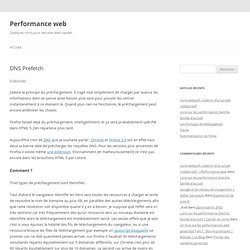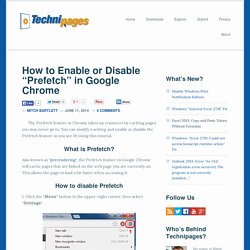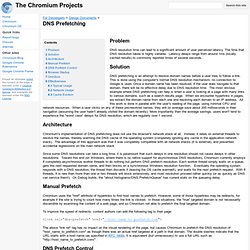

Link prefetching FAQ - MDC. Link prefetching is a browser mechanism, which utilizes browser idle time to download or prefetch documents that the user might visit in the near future.

A web page provides a set of prefetching hints to the browser, and after the browser is finished loading the page, it begins silently prefetching specified documents and stores them in its cache. When the user visits one of the prefetched documents, it can be served up quickly out of the browser's cache. Does prefetching work with HTTPS? Starting in Gecko 1.9.1 (Firefox 3.5), HTTPS content can be prefetched. What are the prefetching hints? The browser looks for either an HTML <link> or an HTTP Link: header with a relation type of either next or prefetch. The same prefetching hint using an HTTP Link: header: Link: </images/big.jpeg>; rel=prefetch The Link: header can also be specified within the HTML document itself by using a HTML meta tag: <meta http-equiv="Link" content="</images/big.jpeg>; rel=prefetch"> Some more examples follow: Yes.
Disable the Firefox Prefetch Setting. Fasterfox - Performance and network tweaks for Firefox. DNS Prefetch — Performance web. J’adore le principe du préchargement.

Il s’agit tout simplement de charger par avance les informations dont on pense avoir besoin plus tard pour pouvoir les utiliser instantanément à ce moment là. Quand plus rien ne fonctionne, le préchargement peut encore améliorer les choses. Firefox faisait déjà du préchargement, intelligemment, et ça sera probablement spécifié dans HTML 5. J’en reparlerai plus tard. Aujourd’hui c’est de DNS que je souhaite parler. Comment ? Trois types de préchargement sont identifiés : Tout d’abord le navigateur identifie les liens vers toutes les ressources à charger et tente de résoudre le nom de domaine au plus tôt, en parallèle des autres téléchargements afin que cette résolution soit disponible quand il y en a besoin.
Le second type de préchargement c’est analyser tous les liens sur lesquels l’utilisateur peut cliquer, pour résoudre par avance le nom de domaine. Le troisième type de préchargement est déclaratif. Pour quoi ? Vie privée et désactivation. Google Chrome: Disable Prefetch. The Prefetch feature in Chrome takes up resources by caching pages you may never go to.

You can modify a setting and enable or disable the Prefetch feature as you see fit using this tutorial. What is Prefetch? Also known as “prerendering“, the Prefetch feature in Google Chrome will cache pages that are linked on the web page you are currently on. This allows the page to load a bit faster when accessing it. DNS Prefetching (or Pre-Resolving) A major goal of Google Chrome was to improve user enjoyment and value in web surfing.

Critical to that is increasing the responsiveness of the browser to user input, or reducing user perceived latency. Measurements in the browser have shown that a significant amount of time is traditionally spent waiting for DNS to resolve domain names. To speed up browsing, Google Chrome resolves domain names before the user navigates, typically while the user is viewing a web page. This is done using your computer's normal DNS resolution mechanism; no connection to Google is used. As a result, user navigation time in Google Chrome when first visiting a domain is on average about 250ms faster than traditional browsing, and the occasional but painful 1-second-plus delays are almost never experienced.
How it works, and how much it helps. DNS Prefetching (The Chromium Projects) Browser Startup Chromium automatically remembers the first 10 domains that were resolved the last time the Chromium was started, and automatically starts to resolve these names very early in the startup process.

As a result, the domains for a user's home page(s), along with any embedded domains (or anything the user "always" visits just after startup), are generally resolved before much of Chromium has ever loaded. When Chromium finally starts to try to load and render those pages, there is typically no DNS induced latency, and the application effectively "starts up" (becoming usable) faster.
Average startup savings are 200ms or more, with common acceleration over 1 second. Omnibox Prefetching is also used in Chromium's omnibox, where URL and/or search queries are entered. Typical Usage If a user resolved a domain name to an IP address recently, their operating system will remember (cache) the answer, and then resolution time can be as low as 0-1ms (a thousandth of a second). Network Usage. Does IE have prefetch header? Prefetch Information - BrowserSpy.dk.